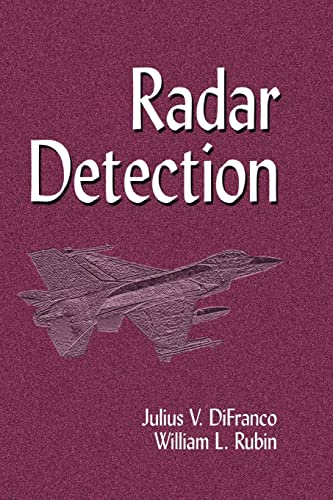Items related to Radar Detection (Radar, Sonar and Navigation)

Synopsis
This book presents a comprehensive tutorial exposition of radar detection using the methods and techniques of mathematical statistics. The material presented is as current and useful to today's engineers as when the book was first published by Prentice-Hall in 1968 and then republished by Artech House in 1980. The book is divided into six parts. Part I is introductory and describes the nature of the radar detection problem. Part II reviews the mathematical tools necessary for a study of detection theory. Part III contains tutorial expositions in a radar context of the classical signal-to-noise and a posteriori theories, both of which have played important roles in the evolution of modern radar. The unifying theme of the book is provided by statistical decision theory, introduced in the last chapter of Part III, which provides the framework for the chapters that follow. The first three chapters of Part IV contain a unified tutorial exposition of single and multiple hit detection theory. The last two chapters are respectively devoted to the use of the radar equation and a discussion of cumulative detection probability. The latter includes a procedure for minimizing the power-aperture product of a search radar. The performance of near-optimum multiple hit detection strategies are considered in Part V. These include binary and pulse train detection strategies. The first chapter in Part VI applies sequential detection theory to the radar detection problem. It includes the Marcus and Swerling test strategy and a two-step approximation to sequential detection. The second chapter contains the development of Bayes decision rules and Bayes receivers for optimizing the detection of multiple targets with unknown parameters, such as range, velocity, angle, etc.
"synopsis" may belong to another edition of this title.
About the Author
Julius V. DiFranco was Research Department Head for Advanced Radar Studies and is a Lifetime Fellow of IEEE.
William L. Rubin was Director of Research for The Sperry Gyroscope Division of Sperry Rand Corporation when this book was written. He is a Lifetime Fellow of IEEE.
"About this title" may belong to another edition of this title.
- PublisherScitech Publishing
- Publication date2004
- ISBN 10 1891121367
- ISBN 13 9781891121364
- BindingPaperback
- LanguageEnglish
- Number of pages670
Shipping:
US$ 2.64
Within U.S.A.
Search results for Radar Detection (Radar, Sonar and Navigation)
Radar Detection
Seller: GreatBookPrices, Columbia, MD, U.S.A.
Condition: New. Seller Inventory # 3242054-n
Quantity: Over 20 available
Radar Detection (Radar, Sonar and Navigation)
Seller: California Books, Miami, FL, U.S.A.
Condition: New. Seller Inventory # I-9781891121364
Quantity: Over 20 available
Radar Detection
Seller: GreatBookPrices, Columbia, MD, U.S.A.
Condition: As New. Unread book in perfect condition. Seller Inventory # 3242054
Quantity: Over 20 available
Radar Detection
Seller: GreatBookPricesUK, Woodford Green, United Kingdom
Condition: New. Seller Inventory # 3242054-n
Quantity: Over 20 available
Radar Detection
Seller: GreatBookPricesUK, Woodford Green, United Kingdom
Condition: As New. Unread book in perfect condition. Seller Inventory # 3242054
Quantity: Over 20 available
Radar Detection
Seller: THE SAINT BOOKSTORE, Southport, United Kingdom
Paperback / softback. Condition: New. This item is printed on demand. New copy - Usually dispatched within 5-9 working days 966. Seller Inventory # C9781891121364
Quantity: Over 20 available
Radar Detection
Seller: moluna, Greven, Germany
Condition: New. Inhaltsverzeichnisrnrnn Part I: Introductionn Chapter 1: Introduction to Radarn Part II: Mathematic Description of Signal and Noise Waveformsn Chapter 2: Mathematical Representation of Waveformsn Chapt. Seller Inventory # 448382702
Quantity: Over 20 available
Radar Detection
Seller: Revaluation Books, Exeter, United Kingdom
Paperback. Condition: Brand New. reissue edition. 300 pages. 8.75x6.00x1.25 inches. In Stock. Seller Inventory # x-1891121367
Quantity: 2 available
Radar Detection
Seller: AHA-BUCH GmbH, Einbeck, Germany
Taschenbuch. Condition: Neu. Neuware - This book presents a comprehensive tutorial exposition of radar detection using the methods and techniques of mathematical statistics. The material presented is as current and useful to today's engineers as when the book was first published by Prentice-Hall in 1968 and then republished by Artech House in 1980. The book is divided into six parts. Part I is introductory and describes the nature of the radar detection problem. Part II reviews the mathematical tools necessary for a study of detection theory. Part III contains tutorial expositions in a radar context of the classical signal-to-noise and a posteriori theories, both of which have played important roles in the evolution of modern radar. The unifying theme of the book is provided by statistical decision theory, introduced in the last chapter of Part III, which provides the framework for the chapters that follow. The first three chapters of Part IV contain a unified tutorial exposition of single and multiple hit detection theory. The last two chapters are respectively devoted to the use of the radar equation and a discussion of cumulative detection probability. The latter includes a procedure for minimizing the power-aperture product of a search radar. The performance of near-optimum multiple hit detection strategies are considered in Part V. These include binary and pulse train detection strategies. The first chapter in Part VI applies sequential detection theory to the radar detection problem. It includes the Marcus and Swerling test strategy and a two-step approximation to sequential detection. The second chapter contains the development of Bayes decision rules and Bayes receivers for optimizing the detection of multiple targets with unknown parameters, such as range, velocity, angle, etc. Seller Inventory # 9781891121364
Quantity: 2 available

